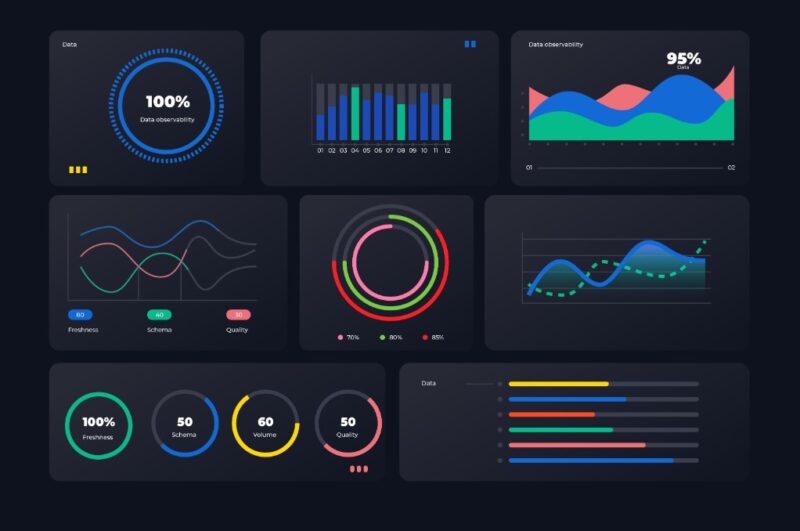In today’s data-driven world, organizations rely heavily on data to make informed decisions and drive business growth. However, ensuring the quality, reliability, and accessibility of data has become increasingly challenging due to the sheer volume and complexity of data sources.
This is where data observability comes into play. As experts in data migration and ETL, Visual Flow understands the critical importance of data observability in enabling organizations to harness the full potential of their data.
Understanding Data Observability
At Visual Flow, we define data observability as the ability to effectively monitor, analyze, and understand data throughout its lifecycle. It goes beyond traditional methods of data monitoring by encompassing key components such as data quality, data lineage, data monitoring, data profiling, and data governance.
Key Components of Data Observability

- Data quality ─ We emphasize the importance of ensuring data accuracy, completeness, and consistency to build trust in the data driving your business decisions.
- Data lineage ─ Tracking the origin and transformation of data is crucial for understanding its lineage and ensuring data integrity.
- Data monitoring ─ Our approach involves continuous tracking and alerting of data anomalies or deviations, allowing for proactive intervention to maintain data quality.
- Data profiling ─ By analyzing data to understand its structure, patterns, and quality, we empower organizations to uncover hidden insights and optimize their data processes.
- Data governance ─ We help organizations establish robust policies and processes for managing data effectively, ensuring compliance with regulatory requirements and maintaining data integrity
Benefits of Implementing Data Observability
Visual Flow’s expertise in data observability brings numerous benefits to organizations, including:
- Improved data quality ─ Enhancing trust and reliability in data-driven decision making.
- Faster troubleshooting ─ Rapid identification and resolution of data issues, minimizing downtime and disruptions.
- Enhanced compliance ─ Meeting regulatory requirements and ensuring data integrity.
- Optimized performance ─ Maximizing the efficiency and effectiveness of data pipelines.
- Better insights ─ Enabling deeper analysis and uncovering valuable insights within data.
Challenges and Best Practices

Visual Flow understands the challenges organizations face in implementing data observability. Through our experience, we have developed best practices to address these challenges, including:
- Addressing data silos ─ Integrating disparate data sources for comprehensive observability.
- Scalability ─ Ensuring observability solutions can handle growing volumes of data.
- Automation ─ Leveraging automation tools and techniques for efficient monitoring.
- Collaboration ─ Fostering collaboration between data engineers, analysts, and other stakeholders.
- Continuous improvement ─ Iteratively refining observability processes to adapt to changing data landscapes.
Implementing Data Observability ─ Step-by-Step Guide
Visual Flow provides a step-by-step guide to implementing data observability, tailored to the unique needs and challenges of each organization:
- Assessing current data infrastructure and processes
- Selecting appropriate observability tools and technologies
- Designing and implementing data monitoring and alerting systems
- Establishing data governance policies and procedures
- Training and educating team members on data observability best practices
Case Studies and Real-World Examples

Visual Flow showcases success stories of organizations that have implemented data observability, highlighting the impact on business outcomes and decision-making processes. These case studies provide valuable insights into the challenges faced, lessons learned, and the transformative power of data observability.
Future Trends in Data Observability
As experts in data migration and ETL, Visual Flow keeps abreast of future trends in data observability, including:
- Evolution of observability technologies and methodologies
- Integration with emerging technologies such as AI and machine learning
- Role of data observability in enabling data democratization and self-service analytics
Conclusion
In conclusion, Visual Flow emphasizes the critical importance of prioritizing data observability in today’s data landscape. By leveraging our expertise in data migration and ETL, organizations can unlock the full potential of their data, driving innovation, and achieving business success in an increasingly competitive market.
As an expert engineer in data migration and ETL, Visual Flow is committed to helping organizations navigate the complexities of the data landscape through comprehensive data observability solutions. Contact us today to learn how we can help you harness the power of your data and drive business growth.

